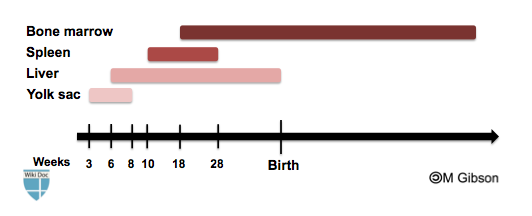Erythropoiesis
|
WikiDoc Resources for Erythropoiesis |
|
Articles |
|---|
|
Most recent articles on Erythropoiesis Most cited articles on Erythropoiesis |
|
Media |
|
Powerpoint slides on Erythropoiesis |
|
Evidence Based Medicine |
|
Clinical Trials |
|
Ongoing Trials on Erythropoiesis at Clinical Trials.gov Trial results on Erythropoiesis Clinical Trials on Erythropoiesis at Google
|
|
Guidelines / Policies / Govt |
|
US National Guidelines Clearinghouse on Erythropoiesis NICE Guidance on Erythropoiesis
|
|
Books |
|
News |
|
Commentary |
|
Definitions |
|
Patient Resources / Community |
|
Patient resources on Erythropoiesis Discussion groups on Erythropoiesis Patient Handouts on Erythropoiesis Directions to Hospitals Treating Erythropoiesis Risk calculators and risk factors for Erythropoiesis
|
|
Healthcare Provider Resources |
|
Causes & Risk Factors for Erythropoiesis |
|
Continuing Medical Education (CME) |
|
International |
|
|
|
Business |
|
Experimental / Informatics |
Editor-In-Chief: C. Michael Gibson, M.S., M.D. [1]
Overview
Erythropoiesis is the process by which red blood cells (erythrocytes) are produced. In human adults, this usually occurs within the bone marrow. In the early fetus, erythropoiesis takes place in the mesodermal cells of the yolk sac. By the third or fourth month, erythropoiesis moves to the spleen and liver. In humans with certain diseases and in some animals, erythropoeiesis also occurs outside the bone marrow, within the spleen or liver. This is termed extramedullary erythropoiesis.
The tibia and femur cease to be important sites of hematopoiesis by about age 25; the vertebrae, sternum, pelvis and ribs continue to produce red blood cells throughout life.
Erythrocyte Differentiation
In the process of red blood cell maturation, a cell undergoes a series of differentiations. The following stages of development all occur within the bone marrow:
- pluripotent hematopoietic stem cell
- multipotent stem cell
- unipotential stem cell
- pronormoblast
- basophilic normoblast/early normoblast
- polychromatophilic normoblast/intermediate normoblast
- orthochromatic normoblast/late normoblast
- reticulocyte
After these stages, the cell is released from the bone marrow, and ultimately becomes an "erythrocyte" or mature red blood cell circulating in the peripheral blood.
These stages correspond to specific appearances of the cell when stained with Wright's stain and examined by light microscopy, but correspond to other biochemical changes.
In the process of maturation a basophilic pronormoblast is converted from a cell with a large nucleus and a volume of 900 µm3 to an enucleated disc with a volume of 95 µm3. By the reticulocyte stage, the cell has extruded its nucleus, but is still capable of producing hemoglobin.
Regulation of Erythropoiesis
A feedback loop involving erythropoietin helps regulate the process of erythropoiesis so that, in non-disease states, the production of red blood cells is equal to the destruction of red blood cells and the red blood cell number is sufficient to sustain adequate tissue oxygen levels but not so high as to cause sludging, thrombosis, or stroke. Erythropoeitin is produced in the kidney and liver in response to low oxygen levels. In addition, erythropoeitin is bound by circulating red blood cells; low circulating numbers lead to a relatively high level of unbound erythropoeitin, which stimulates production in the bone marrow.
Recent studies have also shown that the peptide hormone hepcidin may play a role in the regulation of hemoglobin production, and thus effect erthropoiesis. The liver produces hepcidin. Hepcidin controls iron absorption in the gastrointestinal tract and iron release from reticuloendothelial tissue.1 Iron must be released from macrophages in the bone marrow to be incorporated into the heme group of hemoglobin in erythrocytes.
Fetal Erythropoiesis
The site of erythropoiesis varies according to the age of the fetus. Fetal erythropoiesis occur in the following:
- Yolk sac: 3 weeks - 8 weeks
- Liver: 6 weeks - birth
- Spleen: 10 weeks - 28 weeks
- Bone marrow: 18 weeks - adulthood[1][2]
Shown below is an image depicting erythropoiesis in the fetus and adults.
References
- ↑ Finne PH, Halvorsen S (1972). "Regulation of erythropoiesis in the fetus and newborn". Arch Dis Child. 47 (255): 683–7. PMC 1648245. PMID 4563921.
- ↑ Sharma S, Pati HP, Ahuja RK, Takkar D, Kochupillai V (1997). "Haemopoietic cell composition of human fetal liver, spleen and thymus". Med Oncol. 14 (2): 99–101. PMID 9330269.
